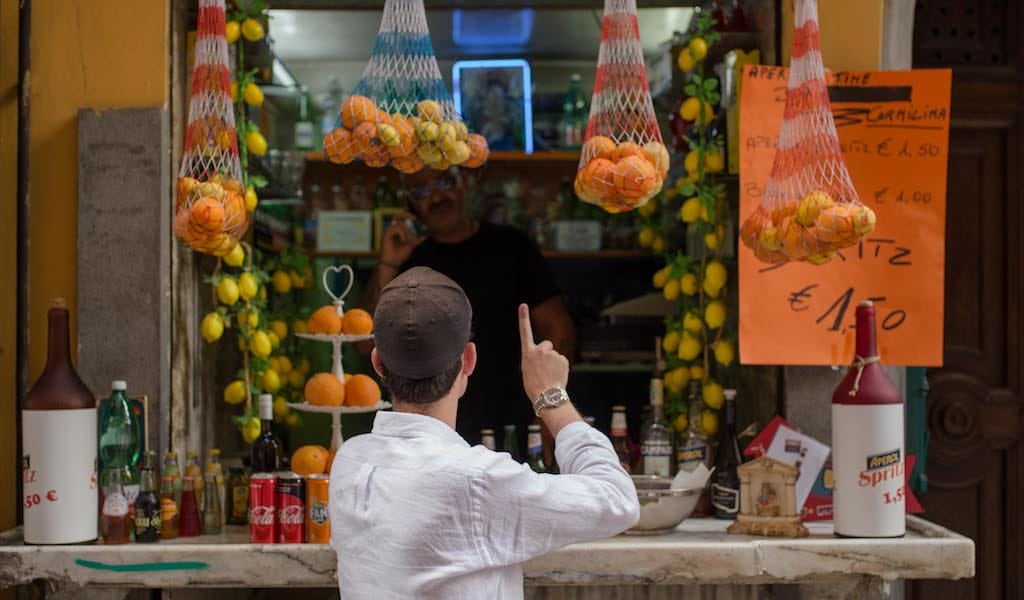Naples has a lot of iconic eateries and shops, but one of the lesser-known city icons is the kiosk of the fresh-water-seller. Scattered throughout the city, the banks of the acquafrescai – some of which are very famous – sell various mineral waters and refreshments.
These kiosks were born to provide relief in the summer months, and for that reason they are widespread in other southern Italian cities, particularly in the Sicilian cities of Palermo, Catania and Syracuse, where the coolness of a granita, a semi-frozen dessert made from sugar, water and various flavorings, counters the oppressive heat.
The water-seller has been around since the Middle Ages. For a longtime it was an itinerant profession: water-sellers traversed cities, traveling far and wide all while trying to keep the water contained in their terracotta amphorae fresh.
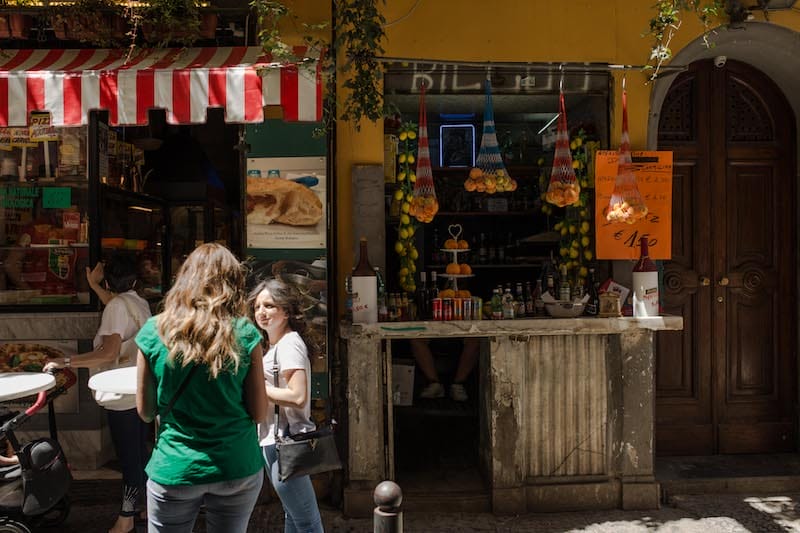
And to the question, “Water-seller, is the water fresh?” the answer was unfailingly, “Like snow.”
It was only during the first half of the 19th century that the Bourbons, a Spanish dynasty that ruled over the Kingdom of Naples, which was later subsumed by the Kingdom of the Two Sicilies, began granting licenses to fresh-water-sellers, which led to the establishment of fixed kiosks. They took the name of banca dell’acqua, or “water bank,” a bank that did not dispense money but coolness. In order to attract customers, each kiosk was decorated in a very flashy way, with lights, embellishments and the famous large oval lemons of Sorrento.
The highest quality water sold by these kiosks was (and still is) sulfur water, coming mainly from the volcanic areas of the Campi Flegrei, and transported and stored fresh in large terracotta pots.
The drink begins to bubble and seethe and should be consumed right after the volcanic eruption takes place in the glass.
Many sought out sulfur water for its purported therapeutic qualities. But much of its success was due to the belief by many Neapolitans that it was an aphrodisiac. The smell and the taste are just like that of a boiled egg, which admitedly is not so arousing, and for this reason we always maintain that it should be drunk down in one gulp, without breathing in its off-putting scent.
In more recent years, these kiosks have expanded their offerings: today they sell every kind of drink, alcoholic ones included, as well as granitas. Some even change up what they serve in winter, when there is less demand for something cool; it’s not out of the ordinary to see kiosks selling octopus broth or roasted chestnuts in the colder months.
“I have been doing this job for 44 years. My father and my grandfather did the same job before me,” says Antonio, whose kiosk is located on Piazza Trieste e Trento. It’s not uncommon for the water banks to be passed down through a family. For example, on a recent visit to Donna Giulia’s kiosk on Via Tribunali, we learned that it’s now run by her son Ciro.
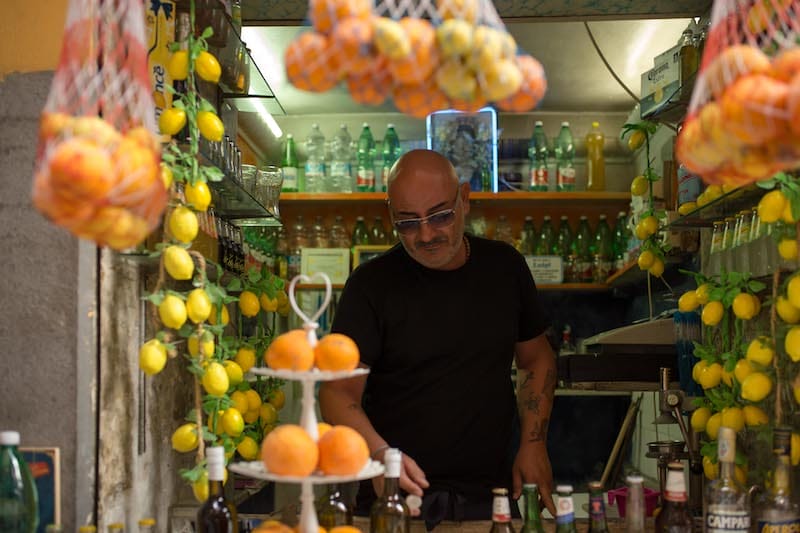
But even as these kiosks expand and change hands, they still always sell sulfur water. And good that they do, as it also happens to be the main ingredient of the most widespread digestive drink in Naples: the Neapolitan gazzosa.
It’s a relatively simple concoction: mix the juice of a squeezed lemon with sulfur water and then, right before serving it, add a bit of bicarbonate. The drink begins to bubble and seethe and should be consumed right after the volcanic eruption takes place in the glass.
The digestive power of the gazzosa is extraordinary. So if you went overboard with pasta or pizza (or both), avail yourself of the Neapolitan soda. And if you drank too much the night before, an explosive gazzosa is really the best hangover drink imaginable.
You can experience the Neapolitan gazzosa at (almost) any fresh-water-seller in the city. Owing to the inevitable march of “progress,” today the sulfur water, which comes from Telese, is now bottled in glass.
We recommend visiting the legendary Aurelio at the Riviera di Chiaia to taste this explosive drink. But it’s also possible to get it from two of the oldest kiosks in Naples, which are located in the city center: Giulia’s charming kiosk on Via Tribunali, next to Pizzeria Gino Sorbillo, and Oasi Chiaia, an ancient water bank on Via Chiaia, next to the Sannazaro Theater.
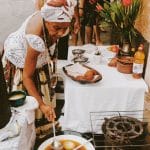 September 6, 2014 First Stop
September 6, 2014 First Stop
Editor’s note: In the latest installment of our recurring feature, First Stop, Tracy […] Posted in Rio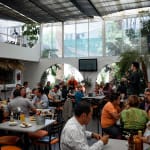 May 17, 2016 Baby Fish
May 17, 2016 Baby Fish
In landlocked Mexico City – the nearest coast is 250 miles away – you might think that […] Posted in Mexico City January 13, 2015 Kozi’s
January 13, 2015 Kozi’s
It’s Friday, 5:30 p.m., an hour one usually associates with tea and biscuits, or in […] Posted in Athens
Published on June 29, 2018
Related stories
September 6, 2014
RioEditor’s note: In the latest installment of our recurring feature, First Stop, Tracy Chang tells us what and where she ate when she was in Rio this summer during the World Cup. Chang headed up marketing and communications for Martín Berasategui at his three-star Michelin restaurant in San Sebastián, Spain, and, upon returning to Boston,…
May 17, 2016
Mexico CityIn landlocked Mexico City – the nearest coast is 250 miles away – you might think that it would be difficult to find fresh seafood. However, ever since Aztec times, the ocean’s bounty has been brought to the valley daily. Back then, the Aztec emperors got their goods using a system of relay runners that…
January 13, 2015
AthensIt’s Friday, 5:30 p.m., an hour one usually associates with tea and biscuits, or in Greece a frappé, yet Kozi’s, a South African restaurant, is pleasantly abuzz with diners tucking into massive steaks and inch-thick burgers. As we stand by the counter waiting for the owner to appear and watching the meat sizzling on the…







































